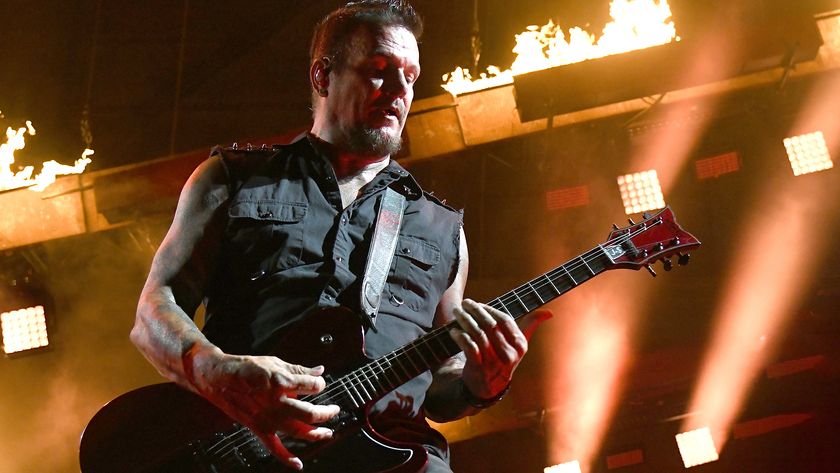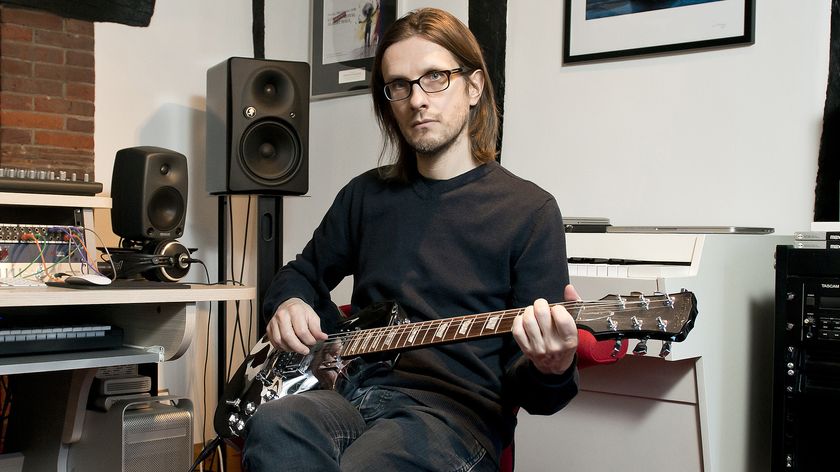“What Captured Me Early on Was the One-Guitar-as-Orchestra Kind of Approach”: Catfish Keith Has Copious Licks in His Bag of Tricks
From slide to fingerstyle, Catfish Keith’s modern technical virtuosity makes old-time country blues simmer with new flavors
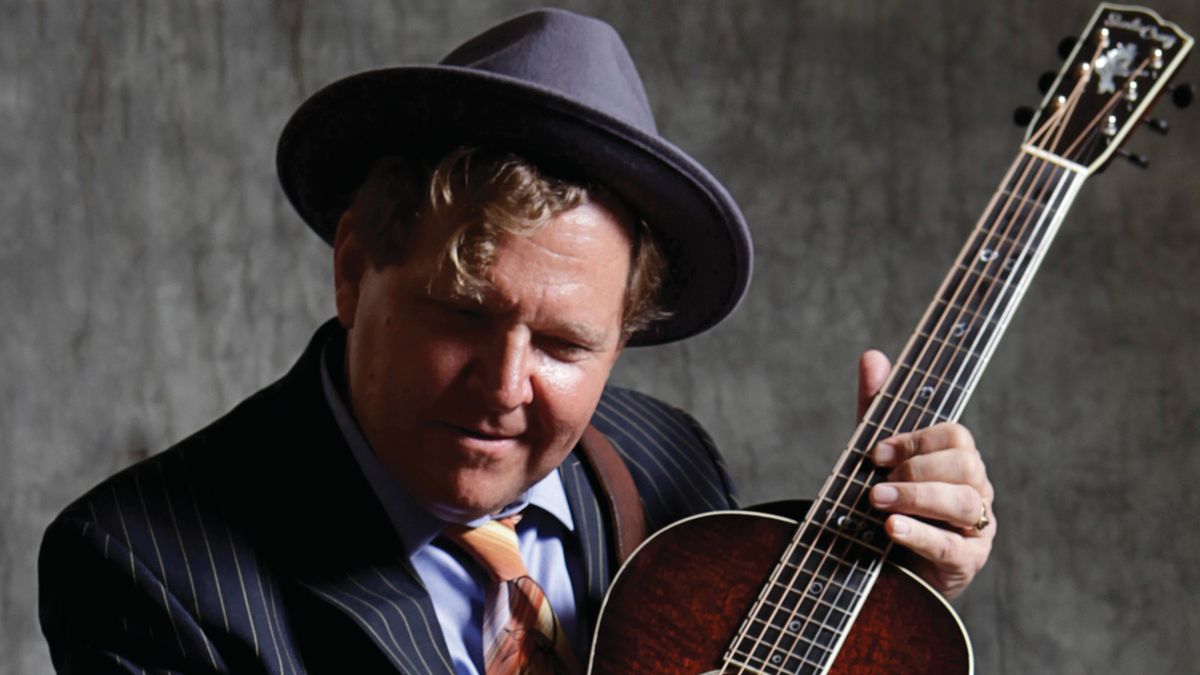
The acoustic performance highlight at this past April’s NAMM Show was a stellar showcase by Santa Cruz Guitar Company signature artist Catfish Keith and his dynamic approach to primal blues. It was somewhat surreal to watch him coax sky-high harmonics from a low-tuned, parlor-sized instrument as his feet kept a heartbeat on his “stomping board,” all while he belted out guttural vocals from the Marriott stage.
Here was a rural roots artist from Iowa performing to a primarily rock crowd in the shadows of Disneyland, re-imagining tunes such as “Stomp That Thing,” which according the liner notes from Keith’s latest album, Still I Long to Roam (Fish Tail Records), was first laid down by Memphis guitar pioneer Frank Stokes nearly a century ago. Killer musicianship is timeless, and Catfish Keith’s technical virtuosity had all the player junkies hooked.
Catfish has copious licks in his bag of tricks. He’s a slide ace who makes a resonator sing, as well as a deft fingerstylist who knows the tradition inside and out. What’s so cool about Keith is how he furthers traditions by breaking new ground in an old-time context. The aforementioned harmonics might first bring to mind traditional greats such as Lenny Breau, Chet Atkins and Tommy Emmanuel.
But as Catfish explains later, his original inspiration goes all the way back to Harpo Marx, and the way he conjures “skank harmonics” is more akin to the squeals of Billy Gibbons, Eddie Van Halen and Zakk Wylde. His understanding of the guitar idiom is encyclopedic. You’d be hard pressed to find a player that knows more about music from the way back to the right now.
This is clearly not nearly Catfish Keith’s first rodeo. Keith Daniel Kozacik was born in East Chicago, Indiana, just over six decades ago, and was inducted into the Iowa Blues Hall of Fame in 2008. A tried-and-true DYI guy, he has 21 albums under his belt on Fish Tail Records, the label headed by his wife, Penny Cahill.
Santa Cruz Guitar Company introduced its custom 1929 O model Catfish Special in 2018. In addition to the formerly mentioned tunes from the new album, “the little guitar with the giant voice” sings distinctively on Keith’s “Cherry Red,” Mississippi John Hurt’s “Louis Collins,” Professor Longhair’s “Go to the Mardi Gras,” the Mississippi Sheiks’ “Bed Spring Poker,” Blind Willie Johnson’s “When the War Was On” and Tommy Johnson’s “Cool Drink of Water.”
Keith has been a regular at the NAMM Show for many moons, and in the years leading up to the pandemic he could regularly be caught at the SCGC house party. I’ll never forget meeting him there just as he’d gotten his dream signature guitar crafted by Richard Hoover and company. When I asked Keith if I could play his new baby, he quickly replied, “No,” and held it close to his body. For a man who’d worked so hard and long, the guitar was understandably too precious to pass around at what was becoming a raucous party rather than a subdued folk house affair.
It was good to see the Santa Cruz gang back in Anaheim this year, and fortunate that they brought Keith. When GP dropped by the house to see if anything was happening, everyone was out to dinner except Penny and Catfish, who had already rustled up some vittles. It was the perfect opportunity for a deep dive with Keith, who was kind enough to offer up leftovers and a beer from the fridge as the conversation turned from casual to shop talk.
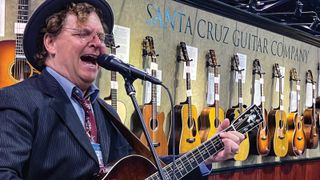
How did you develop a contemporary approach to primitive music?
I am definitely a modern student of all guitar that’s come along. What captured me early on was the one-guitar-as-orchestra kind of approach, where you’re playing bass, melody, harmony, counterpoint and all sorts of ideas within the song structure. I’m talking about players like Ali Farka Touré, John Lee Hooker, R.L. Burnside and Fred McDowell. It all goes back to that Mississippi Hill Country sound, so it’s a modal thing at its most basic, but also its most effective.
Modern guitar techniques came along that were not used in old-time country blues, but I’ll use them in a song like Jessie Mae Hemphill’s “Eagle Bird” that you heard me play today in my own re-imagined way. I took her song and wrote my own song, really. [Hemphill’s tune also inspired “Eagle Birds” by the Black Keys.] The structure is a modal, one-chord thing, but it’s both the easiest and most difficult song in the world for me to play. The notes are very simple, but then there’s the depth of sound coming from the deep-tuned guitar as well as chiming harmonics.
Hawaiian players and some jazz guys, particularly Lenny Breau, influence the kind of harmonics that I try to play, and there was a solo jazz performer named David Winters that I remember seeing when I was just a kid. He would play a whole chorus of a song like “Autumn Leaves” in fingerstyle, and then he’d play a whole chorus all in harmonics. It blew my mind. There was the sound of the harmonics and that they could be used to make every note happen. So I studied how to create harmonics, gathering techniques from a lot of places, including Harpo Marx. [laughs]
I am definitely a modern student of all guitar that’s come along
Catfish Keith
Really? Lenny Breau is probably the primary point of reference from a guitar standpoint. Can you elaborate?
Well, Lenny Breau did the whole cascading thing, and that might use different elements, but oddly enough Harpo Marx is the first guy, because it’s originally a harp technique. Harpo Marx used it in a Marx Brothers movie where he played a whole chorus in harmonics. You start with a deep note and then split it in half. He didn’t have the advantage of fretting the lower notes the way I do on a guitar, but it’s basically a simple version of the same thing, just splitting the note in half, even if the string is fretted.
What exactly do you mean by “splitting the note in half”?
Well, there’s the first octave harmonic, then there’s the second octave harmonic, and then there’s all the other stuff way up in that region that I call “skank harmonics.” If you fret the G string at the second fret to establish the deep note, then you get the first octave harmonic by placing your index finger lightly on the same string over the 14th fret and plucking behind it with your thumb. That’s a very specific spot, but there are a whole bunch of other kinds.
You can play the second octave of the low A by using the same technique up higher on the fretboard somewhere over the sound hole. And all around that spot is a whole world of “skank harmonics.” I essentially place them with the index finger and pluck up with my thumb or middle finger behind it. It’s complex. There’s a whole lot of technique happening up there that I’m not even conscious of when I’m playing.
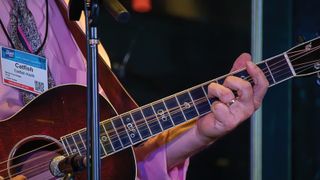
It seems that what you call “skank harmonics” is akin to the pick squeal technique associated with Eddie Van Halen, Billy Gibbons and Zakk Wylde.
Right. It’s related to the stuff you hear on Van Halen, ZZ Top and Ozzy Osbourne songs, except they’re doing it with a pick and I’m doing it with my thumb and first finger. You end up getting some approximated things, but it’s a cool sound and a way of extending the range of the acoustic guitar. I tune down a full step, so my lower notes are a bit lower than usual, and then by going up into the second octave range of the harmonics, the total range is more like a piano.
Doesn’t it seem like a 12-fret acoustic opens up all sorts of harmonics in that sound hole–to-bridge zone while making it much easier to bend the notes as well?
Yeah, it seems to make a big difference. My signature Santa Cruz is 12 frets to the body, and it really helps make that stuff come alive. It’s been a wonderful tool for me because of my history developing this style mostly on a Gibson Nick Lucas, the earliest version, like an L1. It was a 12-fret with what Roy Book Binder calls a “peanut shape.”
My first experience with a Santa Cruz guitar was around 2010 at MerleFest. It was a 13-fret [H13], and I was attracted to it very much because it was a beautiful guitar that was kind of like an old [Gibson] Nick Lucas. So it makes sense that a few guitars later we’d arrive at this design with Richard at Santa Cruz.
I instinctively went toward a small-bodied guitar with 12 frets to the body
Catfish Keith
How did you connect?
It was at NAMM. I was with National Reso-Phonic, and their booth was always near the Santa Cruz booth. I still play Nationals quite a bit, and you can hear them on a few tracks from Still I Long to Roam. That’s a National resonator on “I’m a Wanderer, Fare Thee Well,” and the custom National Baritone Estralia – what I call my Sister Rosetta Tharpe guitar – on “He’ll Understand and Say Well Done.” There’s also a National Exploding Palm Baritone Tricone on the bottleneck slide showcase “Sewing Machine Blues.” Harmonics work well on Nationals as well because they’re like guitars with built-in speakers.
Anyhow, Penny and I were at the NAMM Show. We loved Richard and were always impressed by his instruments. She noticed the Don Edwards model [the Cowboy Singer], which was a small guitar made of all mahogany. That led to my signature model being made of a very unique mahogany that’s a bit less mid-rangey than most mahogany.
I instinctively went toward a small-bodied guitar with 12 frets to the body with that short scale length, because the response is just the way you described it, of having these harmonic zones that are easy to chime, especially when I detune. Sometimes I drop the lowest string, so it ends up being drop C. Sometimes I’ll go with some mysterious detuning.
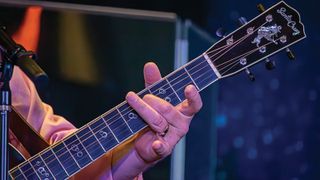
That takes the already bend-y strings and makes them practically like rubber bands.
Yeah, I love to bend and get as much movement as I can way down in the low end and way up in the harmonic range. The idea is to get the most juice out of the guitar. When I’m handed a guitar tuned to standard pitch, the strings feel tight and I have trouble bending them.
Are your nails acrylics?
No, I use fake nails on the thumb and first two fingers, but they’re the plastic stick-on kind. Well, actually they’re glued on with Super Glue. They last for about a week before I need to change them. I wouldn’t be able to pull off the whole style I’ve invented without using those nails.
At what point did you understand what sort of style you wanted to develop?
I’ve been on the same quest since about age 10. By about age 15, I knew that I wanted to be a solo fingerstylist. It came to me as kind of a vision.
At age 10, most guitar kids want to be a rock star, like Eddie Van Halen.
I wanted to be Leo Kottke.
When people say, 'Oh, the sad old blues,' I say, 'What are you talking about?' The whole world of life is in that music
Catfish Keith
You stick your thumb way out hitchhiker-style like Leo.
Yeah, and I do a whole lot of things with the thumb in the bass that are sort of like pulling through the string as you pluck it, and then really rattling the note back and forth with the fretting hand. It’s very wild and springy sounding. Joseph Spence was one of the players that tickled me the most in that sense. He’d play such beautiful, syncopated things, and there’s so much happiness in that music. You can hear him chortling and sort of laughing at himself almost. But you can tell it was pure joy.
When people say, “Oh, the sad old blues,” I say, “What are you talking about?” The whole world of life is in that music. Sister Rosetta Tharpe put all of her ebullience into her fun little virtuosic flurries. She was so cool. She used to look up at the sky when she sang, like looking toward heaven. A lot of people loved her, and I do too. I had such fun putting my spin on her song “He’ll Understand and Say Well Done.” There’s such a treasure trove of songs to mine. I still find endless inspiration in ancient blues. There are still at least a hundred songs I’d like to record in my own style.
What keeps you coming back?
I’m engrossed in how deep the culture of blues music goes, and how powerful a cat can be when it’s just one person with a guitar. How much magic is in that? There is so much. Everybody that picks up a guitar, you just reinvented the guitar. You don’t know it, but you do it just by putting your hands on it and coming up with something. And so in that sense, it’s the most re-inventible instrument. You can put anything into a guitar. It’s a wonderful world.
Get The Pick Newsletter
All the latest guitar news, interviews, lessons, reviews, deals and more, direct to your inbox!
Jimmy Leslie has been Frets editor since 2016. See many Guitar Player- and Frets-related videos on his YouTube channel, and learn about his acoustic/electric rock group at spirithustler.com.

“We would play to five people; they’d ignore us and we'd pack up and go home.” Watch Ian Anderson and guitarist Mick Abrahams regroup the original Jethro Tull for a return to their blues roots

"Shane called me and said, 'The guitar is here. It plays amazing. It's providence calling!’” How an extremely rare goldtop 1958 Les Paul Standard found its way into the hands of Imagine Dragons guitarist Wayne Sermon


